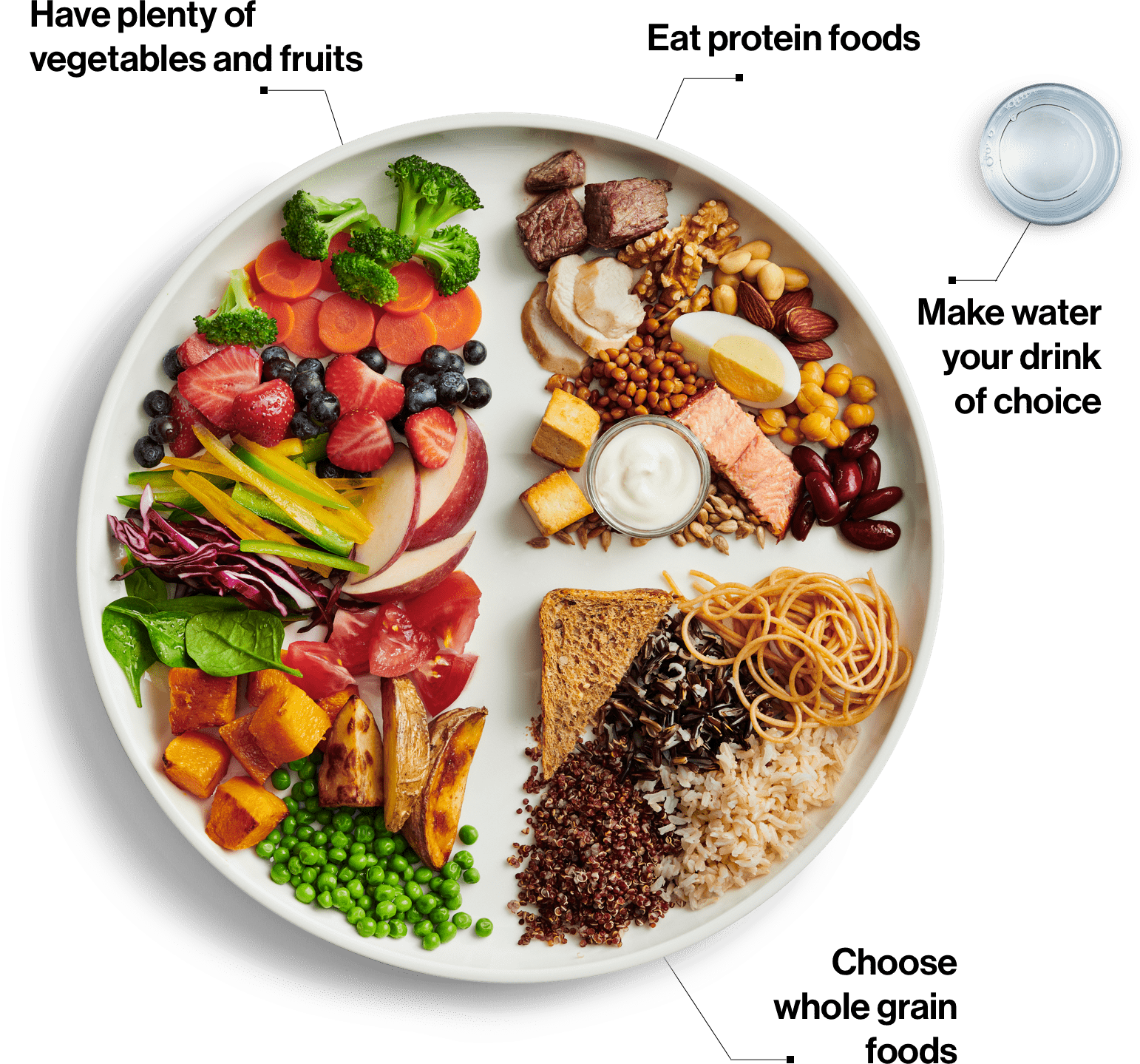By now you may have heard the news: Canada’s Food Guide has changed. The classic rainbow guide we’re used to has been updated to a plate of food called the Food Guide Snapshot.
Compared to the old guide that gave exact serving sizes, the new recommendations are much more simplistic, focusing on what your plate should look like rather than measurements. It’s a high-level overview of not only what we should be eating, but how we should be eating it.
Making Healthier Eating Choices
One of the biggest challenges to living a healthier lifestyle is incorporating more whole foods rather than the overly processed products we’ve come to rely on. From whole grains to more fruits and vegetables, many parents are left wondering how they’re going to get away with changing so much of a picky eater’s plate.
Fear not! Your meals don’t need to change overnight. Learning how to incorporate healthier options into your everyday routine will take time and practice—but it’s something you can focus on as a family.
Keep reading to learn how to organize a healthy meal for kids and how your family can build healthy eating habits (with the help of the New Canada’s Food Guide).
What Makes Up A Healthy Plate For Kids?
Because the new Food Guide doesn’t include portion sizes, you may be wondering what makes up a healthy plate for kids (and adults!). Your plate should be broken into four categories: fruits & vegetables, proteins, whole grains, and beverages.

Image: Courtesy of Health Canada
Fruits and Vegetables
In both the US and Canada, studies find children are not eating enough fruits and vegetables. Perhaps that’s why the new guide recommends fruits and vegetables make up half of your plate. That’s right: 50% of your child’s plate should be fruits and vegetables.
When it comes to preparing meals, try to include a variety of vegetables and fruits in different colors, textures, and shapes. The more variety and color, the better! Some great fresh fruits and veggie options include: Peppers, Cucumbers, Tomatoes, pears, cabbage, peaches, berries, and leafy greens.
In addition to fresh options, the New Canada’s Food Guide recommends frozen or canned vegetables and fruits as another healthy option—as long as you know how to prepare them:
- Skip canned or frozen options that include added sugars, seasoning, or rich sauces.
- Avoid deep-frying vegetables and opt for roasting or steaming instead.
- Keep fruits and veggies washed and cut to make for a quick and easy snack for kids.
Proteins
As an important food group, protein should make up a quarter of your child’s plate. You can find protein in a variety of foods, including nuts, eggs, and shellfish—so there is something for even the pickiest eater.
Opt for proteins that come from a variety of sources, such as plants and meats. When you can, choose plant-based options, as they provide more fiber and less saturated fats. Some protein-filled foods include: eggs, lean meats and poultry, nuts and seeds, fish, beans and lentils, dairy products, and soy products (like tofu).
When it comes to protein, it’s all about making the right choices. The new Canada’s Food Guide suggests making healthy protein-filled choices by:
- Rinsing and draining canned beans, peas and lentils to reduce the amount of sodium
- Opting for fresh or frozen fish that’s not breaded, battered, or deep-fried
- Choosing low-fat and unsweetened dairy products
- Opting for lean cuts of meat, such as rounds and loin
Whole Grains
Choosing whole grains more often is an easy way to improve your family’s eating habits. Whole grains can help lower your risk of stroke, colon cancer, heart disease, and type 2 diabetes.
Try to choose whole grains over refined grains when possible. Whole grains include all parts of the grain, while refined grains have had 1 or more of their 3 parts removed (bran, germ, and endosperm). Some delicious whole grain foods include: quinoa, whole oats and oatmeal, wild rice, whole grain pasta, and whole grain bread.
Certain grain products can contain a lot of sodium, sugars, and fats, and can offer little benefits—so it’s important to know which healthier options to include in your diet. The new Canada’s Food Guide suggests choosing healthy grains by:
- Reading the ingredients and looking for “whole grain oats” and/or “whole grain wheat”
- Add vegetables, vegetable oils, and spices to enhance the flavors of your whole grain dishes
- Try adding a new grain to your recipes each week
- Make dinner together with your child, taking the chance to teach them more about choosing healthy ingredients (in a fun way!)
Beverages
Sugar-sweetened beverages are the number one source of sugar in many people’s diet—and children tend to have the highest intake. For a healthy alternative, swap these sweet and sugary beverages with something simpler: water.
While some children tend to prefer chocolate milk, high-sugar juices, or pop, water is healthier and more beneficial to our bodies. High-sugar pop and juices also tend to contain larger amounts of calories, sodium, and saturated fat—all of which can be avoided by opting for a glass of water instead. Other healthy beverage options include white milk, unsweetened coffee and tea, and plant-based beverages such as soy or almond milk
The new Canada’s Food Guide recommends making the transition away from sugar-sweetened beverages by:
- Adding fresh fruit to hot or cold water to add some extra flavor
- Trying carbonated water for some extra fizz
- Keeping a pitcher of water in the fridge to make it easy to access
- Carrying a reusable water bottle so you and your child can refill on the go

4 Tips For Building Healthy Eating Habits In Kids
A study completed in the United States revealed that over 80% of the US’s population isn’t consuming enough fruits and vegetables, total grains, proteins, and dairy—yet are overeating in the areas of fats, sugars, and sodium.
It’s important to involve children in the kitchen to further their understanding of why healthy eating is so important. Developing your child’s understanding of healthy eating can help positively shape their mindset toward healthy ingredients (and a healthier future).
Good news: building healthy eating habits in kids isn’t as hard as you might think! With the right attitude and activities, children can learn what it takes to be a great (and healthy!) cook in the kitchen.
1. Encourage Mindful Eating
Healthy eating isn’t just about what you eat, but being mindful about your eating habits. Eating mindfully means paying attention to why, when, where, and how much you eat. Understanding these questions can help your family make healthier choices with the foods you eat and the routine of eating, and making positive changes to those habits.
For kids, this can be as simple as allowing them to serve themselves. This can help them learn about servings sizes. Other easy ways to incorporate mindful eating can include eating slowly to fully enjoy the food, and eating only until they feel full. Eating without distractions such as TV, computers, and cell phones also encourages kids to focus on the meal and listening to their bodies.
2. Take Kids Grocery Shopping
Taking children grocery shopping gives parents a chance to start the conversation about the difference between whole foods and processed foods. Here, you’ll have the opportunity to learn and discuss the difference between white and whole grain bread or why you’re choosing oatmeal instead of sugary cereal.
It’s also important to learn how to read and understand food labels to ensure you’re getting the most out of the foods you buy. This allows you to compare products to find the best choice for your family. The grocery store is an excellent place to put your skills to the test and bring the kids along for a learning opportunity.
3. Plan Meals Together
Planning meals together helps involve kids in the process of deciding what’s going to be on their plate. Whether you’re planning a day ahead or weeks in advance, involving kids in the process can teach them what it takes to create a healthy meal, from getting the ingredients at the grocery store to preparing it for dinner.
Planning meals ahead of time also gives kids the opportunity to voice opinions on what they would like to try preparing. Maybe they had something at a friend’s house or enjoyed a dish while you were out for dinner. Getting kids involved in this process can help them develop an interest in exploring new things.
4. Invite Kids Into the Kitchen
One of the most important tips for creating healthy eating habits in kids is bringing them into the kitchen to prepare meals. Regardless of their age, there’s a job for everyone, whether it’s reading the recipe or helping mix the ingredients.
Not only can this teach the vital life skill of cooking, but it can also allow children to become familiar with the habit of cooking instead of opting for pre-packaged processed food options. When cooking becomes an enjoyable habit instead of a nuisance, healthy lifestyle choices start to fall into place.

Start Building Healthy Eating Habits!
If you’re looking for more resources from the new Canada’s Food Guide or eating healthy with kids, check out some of the useful resources below:
Canada’s Food Guide
11 Ways Your Family Can Build Healthy Eating Habits
The Ultimate Guide To Snacking On-The-Go
12 Tips For Healthy Meal Planning (On A Budget)



